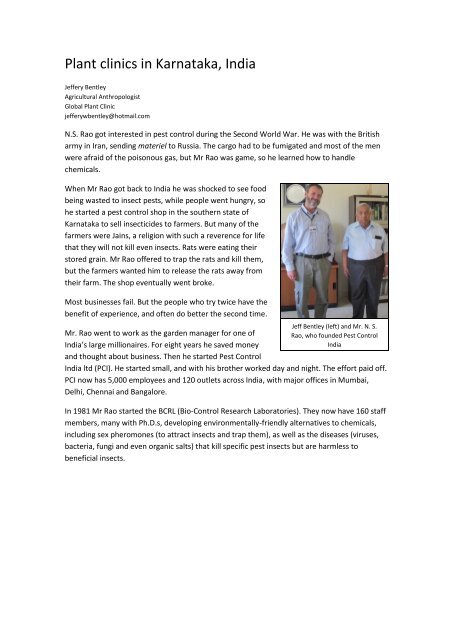Plant Clinics in Karnataka, India, 2011 - Jeffery Bentley
Plant Clinics in Karnataka, India, 2011 - Jeffery Bentley
Plant Clinics in Karnataka, India, 2011 - Jeffery Bentley
Create successful ePaper yourself
Turn your PDF publications into a flip-book with our unique Google optimized e-Paper software.
<strong>Plant</strong> cl<strong>in</strong>ics <strong>in</strong> <strong>Karnataka</strong>, <strong>India</strong><br />
<strong>Jeffery</strong> <strong>Bentley</strong><br />
Agricultural Anthropologist<br />
Global <strong>Plant</strong> Cl<strong>in</strong>ic<br />
jefferywbentley@hotmail.com<br />
N.S. Rao got <strong>in</strong>terested <strong>in</strong> pest control dur<strong>in</strong>g the Second World War. He was with the British<br />
army <strong>in</strong> Iran, send<strong>in</strong>g materiel to Russia. The cargo had to be fumigated and most of the men<br />
were afraid of the poisonous gas, but Mr Rao was game, so he learned how to handle<br />
chemicals.<br />
When Mr Rao got back to <strong>India</strong> he was shocked to see food<br />
be<strong>in</strong>g wasted to <strong>in</strong>sect pests, while people went hungry, so<br />
he started a pest control shop <strong>in</strong> the southern state of<br />
<strong>Karnataka</strong> to sell <strong>in</strong>secticides to farmers. But many of the<br />
farmers were Ja<strong>in</strong>s, a religion with such a reverence for life<br />
that they will not kill even <strong>in</strong>sects. Rats were eat<strong>in</strong>g their<br />
stored gra<strong>in</strong>. Mr Rao offered to trap the rats and kill them,<br />
but the farmers wanted him to release the rats away from<br />
their farm. The shop eventually went broke.<br />
Most bus<strong>in</strong>esses fail. But the people who try twice have the<br />
benefit of experience, and often do better the second time.<br />
Mr. Rao went to work as the garden manager for one of<br />
<strong>India</strong>’s large millionaires. For eight years he saved money<br />
and thought about bus<strong>in</strong>ess. Then he started Pest Control<br />
Jeff <strong>Bentley</strong> (left) and Mr. N. S.<br />
Rao, who founded Pest Control<br />
<strong>India</strong><br />
<strong>India</strong> ltd (PCI). He started small, and with his brother worked day and night. The effort paid off.<br />
PCI now has 5,000 employees and 120 outlets across <strong>India</strong>, with major offices <strong>in</strong> Mumbai,<br />
Delhi, Chennai and Bangalore.<br />
In 1981 Mr Rao started the BCRL (Bio-Control Research Laboratories). They now have 160 staff<br />
members, many with Ph.D.s, develop<strong>in</strong>g environmentally-friendly alternatives to chemicals,<br />
<strong>in</strong>clud<strong>in</strong>g sex pheromones (to attract <strong>in</strong>sects and trap them), as well as the diseases (viruses,<br />
bacteria, fungi and even organic salts) that kill specific pest <strong>in</strong>sects but are harmless to<br />
beneficial <strong>in</strong>sects.
Mr Rao is now 92 and he still visits the offices and labs.<br />
BCRL is not the biggest money maker <strong>in</strong> PCI, but Mr Rao<br />
calls BCRL “the heart of the company.” He wants it to<br />
give someth<strong>in</strong>g to society.<br />
Dr. Malvika Chaudhary looks after the quality control<br />
at BCRL, which develops and manufactures<br />
sophisticated bio-control projects for sale. In 2008,<br />
Malvika was look<strong>in</strong>g at cl<strong>in</strong>ics as a way of help<strong>in</strong>g<br />
farmers diagnose plant problems, to encourage<br />
appropriate use of BCRL products.<br />
Malvika found a paper on plant cl<strong>in</strong>ics <strong>in</strong> Bangladesh, by Paula Kelly (Global <strong>Plant</strong> Cl<strong>in</strong>ic) on the<br />
web, and wrote to her. Eric Boa of the Global <strong>Plant</strong> Cl<strong>in</strong>ic met Malvika at a conference <strong>in</strong> Delhi,<br />
and later gave a course on plant cl<strong>in</strong>ics to BCRL. Malvika and colleagues started runn<strong>in</strong>g plant<br />
cl<strong>in</strong>ics <strong>in</strong> 2009. They gradually began to th<strong>in</strong>k of the cl<strong>in</strong>ics more as part of their CSR (corporate<br />
social responsibility).<br />
One bright Saturday morn<strong>in</strong>g <strong>in</strong> April, Dr. Malvika Chaudhary picked me up to show me BCRL. I<br />
was surprised to f<strong>in</strong>d the whole staff there. They work six days a week. Her one day off is<br />
Sunday, which she often spends with her colleagues runn<strong>in</strong>g one of their four regular plant<br />
cl<strong>in</strong>ics. “I don’t th<strong>in</strong>k of it as work,” Malvika says. That’s how much she enjoys the cl<strong>in</strong>ics.<br />
They have had many experiences with plant cl<strong>in</strong>ics, but are settl<strong>in</strong>g down to run the four,<br />
regular cl<strong>in</strong>ics. That is what they can handle, and do well, with all their other tasks. Malvika<br />
often goes to the cl<strong>in</strong>ics with the head of field research, M.S. Prabhakara, and Usha Nand<strong>in</strong>i,<br />
technical officer at BCRL.<br />
The BCRL plant cl<strong>in</strong>ics are held once a month.<br />
First, they send one of the company extension<br />
agents out to the village. He puts up a banner<br />
at the cl<strong>in</strong>ic site, with the time and date. He<br />
tells some of the farmers about the cl<strong>in</strong>ic, and<br />
asks them to tell their neighbours.<br />
On cl<strong>in</strong>ic day about three people usually come<br />
from BCRL. They do many th<strong>in</strong>gs that people<br />
do at plant cl<strong>in</strong>ics everywhere. They have a<br />
sign. They fill out the cl<strong>in</strong>ic log (or register)<br />
and they write prescriptions. They keep a<br />
carbon copy of the prescription<br />
Left to right, Malvika Chaudhary, M.S.<br />
Prabhakara and Usha Nand<strong>in</strong>i<br />
As <strong>in</strong> a plant cl<strong>in</strong>ic anywhere, experts give farmers<br />
<strong>in</strong>dividual attention. Mr Krishnappa tells Usha<br />
about his problems with bean pod borer<br />
<strong>Plant</strong> cl<strong>in</strong>ics <strong>in</strong> <strong>Karnataka</strong> 2
At first, the company extension agents were so excited, they<br />
ran around literally dragg<strong>in</strong>g farmers <strong>in</strong>. But Malvika<br />
stopped them. She only wants to see farmers who are<br />
motivated with real problems. Twelve or 15 farmers like<br />
that do come. Most br<strong>in</strong>g samples of their plant problems.<br />
The fieldwork has been good for the team. In two years of<br />
runn<strong>in</strong>g plant cl<strong>in</strong>ics they have learned to identify many<br />
problems they did not recognize at first. They were able to<br />
take samples to a university <strong>in</strong> Bangalore which helped them identify tricky problems.<br />
Now the BCRL people can identify most of the farmers’<br />
problems on the spot. Like the plant cl<strong>in</strong>ics worldwide,<br />
when the BCRL can identify a problem they give farmers a<br />
written and verbal recommendation then and there. But<br />
the team takes any problems they can’t diagnose to the lab.<br />
For example, if a bean plant is killed by collar rot, it could be<br />
from fungi or bacteria, so the team takes a sample to their<br />
lab. Two days after they usually have a diagnosis, and they<br />
phone farmers on their cell phones and tell them the<br />
results.<br />
Usha expla<strong>in</strong>s <strong>in</strong>formation from the <strong>in</strong>ternet about<br />
grape management to Mr. Ashok<br />
But BCRL has also made many <strong>in</strong>novations <strong>in</strong> runn<strong>in</strong>g<br />
plant cl<strong>in</strong>ics. For example, they keep a photo record of<br />
every sample. They write the sample’s code on a slip of<br />
paper, put it on a neutral background with the sample,<br />
and take a picture. This forms part of their permanent<br />
record.<br />
The team takes a laptop to the cl<strong>in</strong>ic and gets on the<br />
<strong>in</strong>ternet to look up more <strong>in</strong>formation for farmers.<br />
The prescription form has lots of<br />
room for writ<strong>in</strong>g a full<br />
recommendation<br />
Fungus or bacterium? Tak<strong>in</strong>g a<br />
sample of a rotten bean plant,<br />
with soil, for lab analysis<br />
Tak<strong>in</strong>g a photo of a sample,<br />
<strong>in</strong>clud<strong>in</strong>g its code number, helps<br />
to keep a permanent record<br />
Usha uses fact sheets to help give<br />
recommendations<br />
<strong>Plant</strong> cl<strong>in</strong>ics <strong>in</strong> <strong>Karnataka</strong> 3
The BCRL team also takes fact sheets to the cl<strong>in</strong>ic, and uses them<br />
there. This helps a lot. They expla<strong>in</strong> the fact sheets to the<br />
farmers. That helps the team to remember the recommendation.<br />
If the farmers are <strong>in</strong>terested, and most are, the plant doctors tell<br />
them more.<br />
BCRL also takes a book of lam<strong>in</strong>ated photos to the cl<strong>in</strong>ic. If<br />
farmers have not brought a sample they can flip through the<br />
book until they f<strong>in</strong>d it. In the Yelakana farmers’ market <strong>in</strong><br />
Bangalore I watch a farmer look at the pictures until he f<strong>in</strong>ds the<br />
photo of the pest that is bother<strong>in</strong>g his grapes. The staff<br />
recognizes it as thrips, and can give him the recommendation.<br />
BCRL also does telephone follow up, of each farmer who visits<br />
the cl<strong>in</strong>ic. Two weeks later, BCRL technical officer Usha calls<br />
them and asks them about their experience. Did they apply the<br />
recommendation? Was it useful? Did it control the plant health<br />
problem?<br />
BCRL enters all the data from the cl<strong>in</strong>ic register <strong>in</strong>to a<br />
computerized data base (name, phone number, problem etc.). But<br />
it is gett<strong>in</strong>g to be so much work that she now needs a full-time<br />
person to do only this.<br />
<strong>Plant</strong> cl<strong>in</strong>ics help researchers to learn about farmers’ needs (and<br />
practical solutions). Head of field research, M.S. Prabhakara, says<br />
“I learn a lot (at the cl<strong>in</strong>ic), maybe more than the farmers. The<br />
cl<strong>in</strong>ics are an opportunity to systematically document everyth<strong>in</strong>g,<br />
with photos, and to write fact sheets. I am empower<strong>in</strong>g myself by<br />
work<strong>in</strong>g on these th<strong>in</strong>gs.”<br />
A second Mr. Krishnappa<br />
f<strong>in</strong>ds a photo of the thrips<br />
<strong>in</strong>sects that are bother<strong>in</strong>g<br />
his grapes<br />
Gett<strong>in</strong>g feedback from<br />
farmers over the phone<br />
The BCRL plant doctors recommend their own biological products (<strong>in</strong>clud<strong>in</strong>g the pheromones<br />
and salts) when possible, but as Prabhakara says, perhaps only 5 or 10% of farmers’ plant<br />
health problems can be solved with these. There is much research to be done. The cl<strong>in</strong>ic<br />
recommends chemical control for problems which have no other solution.<br />
Two weeks after hold<strong>in</strong>g the cl<strong>in</strong>ic, the team goes back and offers the farmers a demonstration<br />
on one of the problems that emerged from the previous cl<strong>in</strong>ic session.<br />
<strong>Plant</strong> cl<strong>in</strong>ics <strong>in</strong> <strong>Karnataka</strong> 4



